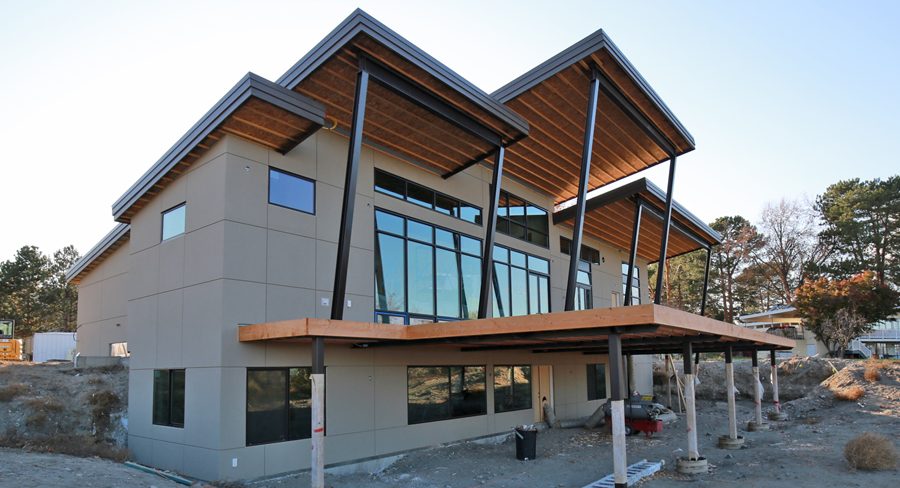
Home » Contractors squeezed by higher costs while demand remains strong
Contractors squeezed by higher costs while demand remains strong

January 14, 2019
By Jennifer L. Drey
Increased costs for materials and labor, coupled with national tariffs and state regulations are presenting challenges and squeezing margins for general contractors in the Tri-Cities as demand for construction remains heavy, according to those in the industry.
Nationally, the costs of all inputs to construction increased by 4.9 percent between November 2017 and November 2018, according to U.S. Bureau of Labor Statistics data. The figure refers to construction items included in every project, as well as materials consumed by contractors, such as diesel fuel, and services like trucking and equipment leasing.
“People think we’re making more, but more is going out,” said Dennis Poland, president of Kennewick-based Ray Poland & Sons.
Prices on certain materials have moderated in recent weeks, but construction firms still are likely to pay higher prices on other materials in the coming year due to the 25 percent tariff on steel and 10 percent tariff on aluminum implemented earlier this year, according to Ken Simonson, chief economist at the Associated General Contractors of America. Steel and aluminum are both used heavily in construction.
“It appears the tariffs imposed on steel, aluminum and thousands of Chinese imports are starting to effect the cost of many items used in construction,” Simonson said.
Locally, at MH Construction in Kennewick, Vice President Alex Linde said that while the price of construction materials may be rising, he sees the bigger increase in labor costs. As a general contractor, he said it can be difficult to determine whether price increases from subcontractors reflect higher material costs or higher labor costs, but given the extreme labor shortage in the Tri-Cities, he believes it to be the latter.
“Materials may stay the same, but what I’m finding is that labor is the deciding factor. That’s where I’m seeing all of the price increases coming from,” Linde said.
The labor shortage is being compounded by the unusually low unemployment rate and high demand for construction in area, but Linde believes it has actually been building for more than a decade as schools have funneled teens toward college rather than jobs in the construction industry.
Linde would like to see the construction industry presented to teenagers as an equally viable — if not better — option to college. He’d also like to see teenagers gain hands-on experience on construction sites prior to turning 18, but state regulations generally don’t allow it.
“We allow kids at 16 to drive, yet we don’t allow them to work a Skilsaw, so we can’t employ 16- or 17-year-olds on the construction sites during the summer,” he said. “We don’t even allow them to touch the industry until after they’ve completed high school.”
State regulations also can drive up operational costs for general contractors, according to Poland, who cited state requirements for mandatory paid-family-leave time and ongoing state fuel taxes as costly state regulations.
“These laws and regulations have consequences. It comes back to the fact that it’s a matter of price,” Poland said.
Additionally, prices for mandatory equipment such as fuel trucks, excavators and even pickup trucks have skyrocketed in the past 10 years, he said.
Angelo Ciulla, senior project manager at Elite Construction & Development in Pasco, said prices for certain materials used in construction hit an all-time high last spring and summer, as the newly implemented tariffs, along with natural disasters such as wildfires and hurricanes, led to sudden price increases of as much as 50 percent. At that time, material costs were increasing so quickly that price proposals from suppliers that would have normally been good for 15 to 30 days were only being honored for 24 to 48 hours, he said.
Despite the higher cost of materials and labor, the appetite for construction in the Tri-Cities has not waned, forcing general contractors to think carefully about when to pass along price increases to the customer and when to accept lower margins.
With limited labor to go around, especially at the subcontractor level, general contractors also are being forced to be selective about which projects to take on, Linde said.
As a general contractor, MH Construction relies heavily on subcontractor bids, where the shortage is most pronounced. Often, subcontractors simply aren’t bidding right now, he said.
“We’ll put out an invitation to bid and we’re begging people sometimes to bid them because they’re being picky. It’s almost like we need to sell them the job,” Linde said. “Good jobs that anybody would be happy to bid, people just aren’t bidding them.”
At Elite Construction, the labor shortage and increased pricing has led the company to approach projects differently than in the past, often doing work that may have been subcontracted before, Ciulla said.
But while demand for construction remains strong, the natural ebb and flow of the local economy points to an eventual slowdown, which should help to correct the labor shortage, contractors said.
Recent growth in the Tri-Cities has made the area home to a number of high-dollar public projects, such as new public schools, that have brought excess work to the area, but many are once-in-a-generation-type projects, the scope of which will not been seen again for a long time, Linde said.
For customers looking to complete projects now, he advises keeping an open schedule and understanding that what seems like a six-month project is more likely to take nine months to a year.
He said customers should be prepared to choose one area for compromise — either price, quality or speed.
“Assuming no one wants to compromise on quality, I think everyone’s just going to have to compromise on speed if they don’t want the prices to go way high,” he said.
Real Estate & Construction Local News
KEYWORDS january 2019




